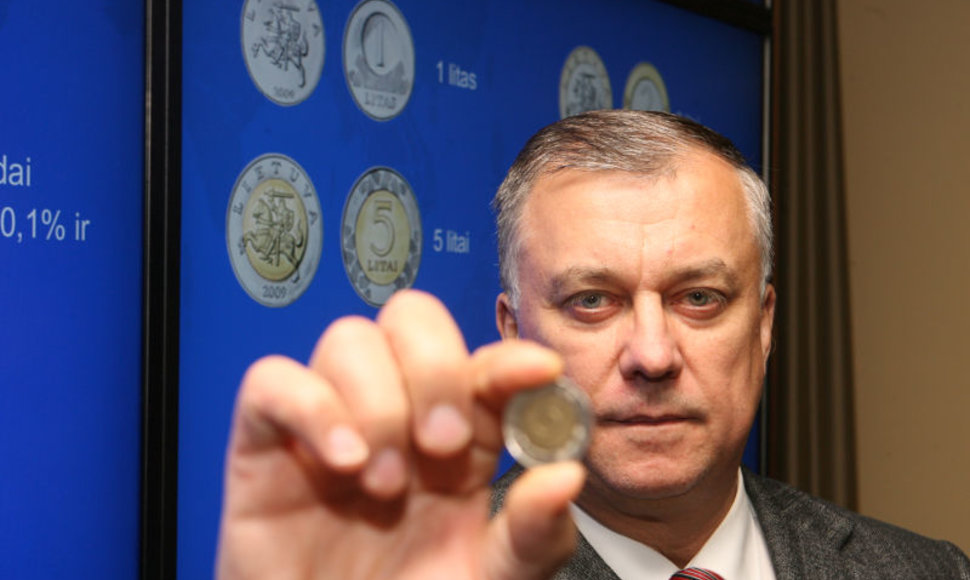Part of the litas' emotional resonance came from the fact that the Lithuanian national currency first saw the light of day over seven decades before, in 1922, when the first interwar Republic released released it into circulation.
“Now that was some currency!” recalls 86-year-old TV director and actor Galina Dauguvietytė, who held the inter-war litas notes in her own hands. “Even the rest of the world regarded it as a strong currency – incredibly strong. Mother would take litas to Germany and feel like Queen Elizabeth II. You have no idea!”
The life of the Lithuanian litas was interrupted by World War Two and Soviet annexation. Since 1941, Lithuania had to do with currencies introduced by occupying powers, first Nazi Germany, then the Soviet Union. The litas did not reappear until 25 June 1993, several years after Lithuania had declared independence.
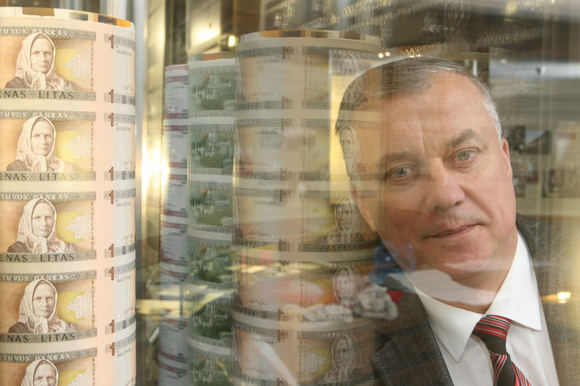 |
| Laurinavičius with 1, 2, and 5 litas bills |
Secrecy and opposition
If the current government's ambition to join the euro zone in 2015 comes to fruition, Lithuania's national currency will be taken out of circulation and litas notes will be sent to special money disposal machines. Over 90 million banknotes (some 90 tons of paper) will be shredded and pressed into bricks. The Bank of Lithuania will only keep a small amount for collectors.
The end of the litas will likely go much more smoothly than its beginning two decades ago. The idea of rebuilding a national monetary system was first put forward back in 1988 when Professor Stasys Uosis mentioned it at a meeting of the Science Academy's Institute of Economics scholars.
We had no experience, no people who knew how to make notes, how to coat them, what paper stock to use, no one to print them, above all, no idea of what national symbols must be on the notes – until then, we'd get all our money from Moscow.
The idea was met by resistance from some scholars and the entire Soviet banking establishment. Yet despite the pressure, on 18 May 1989, the Supreme Council passed a law “On the Economic Autonomy Outlines of the Lithuanian SSR” which included provisions for a separate currency and credit system.
Soon afterwards, a task group of economics scholars from Vilnius University and practising bankers was formed. Within six months, they presented a concept for a monetary system and required legislation.
The Science Academy's Institute of History was tasked with presenting recommendations about personalities, historic and architectural monuments worthy of depiction on Lithuanian banknotes.
Basics of making money
Lithuania declared independence from the Soviet Union on 11 March 1990, which opened the way for creating a functioning central bank and introducing a national currency.
“And that is not something that can be done in a day. After all, we had no experience, no people who knew how to make notes, how to coat them, what paper stock to use, no one to print them, above all, no idea of what national symbols must be on the notes – until then, we'd get all our money from Moscow,” recalls Vidmantas Laurinavičius, director of the Money Museum at the Bank of Lithuania.
At the time, Kęstutis Jonas Lynikas, a Lithuanian-Australian and expert of money printing, was visiting the country.
“He advised us, gave proposals. We corresponded by mail, too, he sent us sketches by Australian artists of how our national money might look like. After all, we didn't know even the basics of the craft – for instance that it is not a good idea to put someone's portrait in the centre of the note, because it's where the folding line goes,” Laurinavičius recalls.
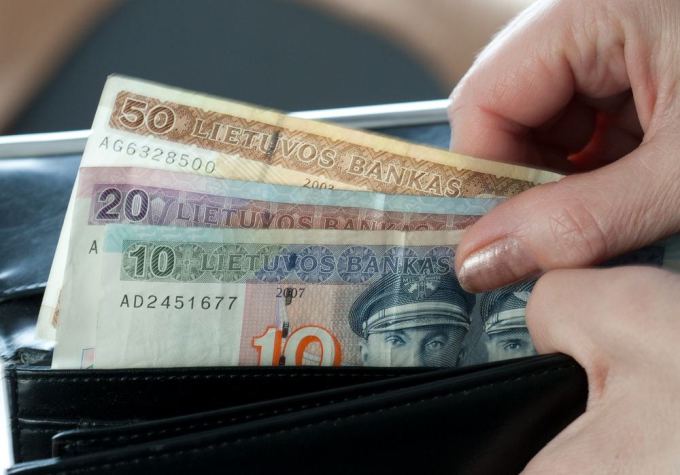 |
| Pinigai |
Visions of money
Amidst disagreements and uncertainties about the future national currency, one thing was clear though – the name. Everyone agreed that the Lithuanian money would be called “litas.” The name was developed back in 1922, following heated debates in the Constituent Seimas and the press of the First Republic.
“Almost every MP had a suggestion. Minutes from the Constituent Seimas sittings list some quite bizzare names: muštinis (chop), auksinas (gulden), arfa (harp), grašis, doleris (dollar), kaltas (chisel), kirptukas, lietas, lietus (rain), lyra, vytis. Eventually, however, they adopted a proposal by the Seimas Economic Commission to name the currency litas, an abbreviation deriving from 'Lithuania', and its one-hundredth part, centas,” Laurinavičius says.
So in the 1990s, the name was clear. What was needed was a face. A group of Lithuanian artists, led by graphic artist Raimundas Miknevičius, spent hours labouring on the visual appearance of litas notes. Others who worked on the designs were L.Pocius, G.Jonaitis, A.Mandeika, R.Bartkus, J.Tolvaišis, R.Valantinas.
“When we were designing the money, we were all autodidacts. No one had ever instructed either politicians or artists on how to make banknotes,” says Rytis Valantinas, author of the 100 and 200 litas notes, as quoted in Rimantas Dichavičius' book Marked by Freedom (Laisvės paženklinti).
“I was commissioned to sketch the 10 litas note, Justas Tolvaišis got 20 litas, Ray Bartkus, 50. They would give us a theme, what to depict. Our job was to stylize, select proportions,” artist Giedrius Jonaitis tells 15min.
When we were designing the money, we were all autodidacts. No one had ever instructed either politicians or artists on how to make banknotes.
He is the author of all litas note designs, safe for 100 litas and 200 litas: “Bartkus emigrated to the US, others dispersed as well – I had to take over.”
Several years ago, Jonaitis' design for the 10 litas note was put on the cover of World Paper Money catalogue. “Sure, this sign of acknowledgement pleased my vanity, although I do not believe it's the prettiest banknote in the world. To be honest, I was sceptical about our money ever going into use – I saw this job more like sketching a vision,” Jonaitis admits.
Under the eye of special services
Once the designs were ready, money had to be printed. But there was no chance of issuing a public call for tenders. The foundations for national currency were laid in total secrecy.
“We declared Independence, but it was a declarative move – the Soviet army was still stationed in Vilnius, we had no control of our borders, KGB structures were in operation,” Laurinavičius explains.
“Law enforcement institutions have learnt that at least three professional KGB agents were following the affairs of litas printing from the very start. […] One of them instructed to remove security threads from some litas bills. […] Soviet special services tried to control the production of Latvian lats and Estonian kroons, too” historian Vladas Terleckas writes in his book Challenges of Falsifying and Degrading of the Lithuanian History (Lietuvos istorijos klastojimo ir niekinimo iššūkiai).
“Everything was done under constant, even physical threat,” the then chairman of the Supreme Council Vytautas Landsbergis once said.
In 1990, Lithuania opened negotiations on printing the bills with French company François-Charles Oberthür. Even though it was a private company, it was subjected to considerable political pressure.
“They did not turn our order down, but they asked for financial guarantees and we could not give them. There was some friction,” says the Money Museum director.
Then the Lithuanian government decided to look for partners from across the Atlantic – the order was given to American company US Banknote Corporation.
Unprotected bills
The first delivery of litas notes reached the country in 1991. They were transported by sea to Klaipėda, taken to Vilnius and stocked in the Bank of Lithuania vaults.
Compared to anti-counterfeiting measures used on today's bills, those banknotes were only minimally protected and some not at all.
The American company printed 10, 20, and 50 litas notes in offset, without using intaglio printing. Intaglio was only used on 100, 500, and 1,000 litas notes.
However, when the litas was finally introduced in June 1993, the 500 and 1000 litas notes never went into circulation.
“They followed the generally accepted rule that the highest-denominated bill in circulation should be equal to about one half of the average salary in the country. At the time, the average salary in Lithuania was about 150 litas. So even the 100 litas bills were too big for us, but released nevertheless. And it was the only protected bill,” Laurinavičius relates.
Lithuania sued the American company for substandard services and spent years in litigation. “Do you think the Americans expected we'd actually use the money? What they thought was: here we have a business contract so let's do it! And they tampered with quality. But we won the case.
“The Americans should have used intaglio printing for 50, 20, and 10 litas notes – and the court ordered them to do it in 1993. Later, however, Lithuania wanted nothing to do with that company,” Laurinavičius summarizes.
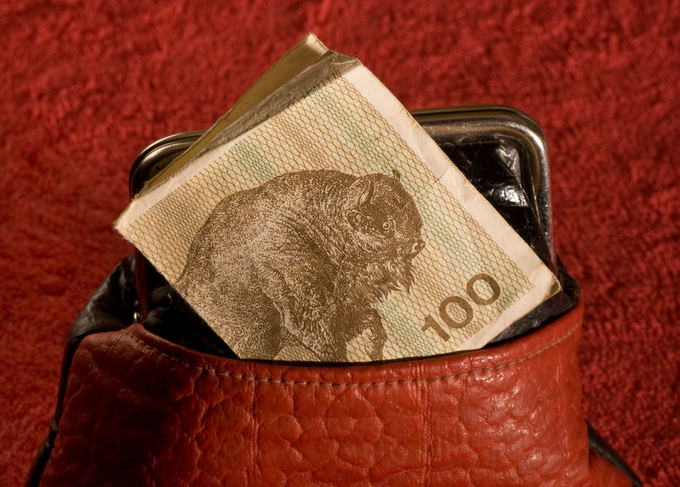 |
| Talonai, also known as vagnorkės, were ussed as a temporary currency |
Roubles to “vagnorkės”
Whatever the quality, the litas bills were in Lithuania by 1991. Why did it take another two years before they went into circulation?
Political and economic circumstances altered plans for building a national monetary system. At the time, public finances were in disarray and the government pursued inflationary monetary policies which were not favourable to introducing the litas. It would have devalued quickly thus discrediting the very idea of a national currency.
Prices were skyrocketing, goods were in increasingly short supply, as were roubles. Salaries, pensions, student grants, benefits of all sorts were late. The prevailing political and economic climate at the time left little hope of receiving an injection of cash from the State Bank of the USSR, therefore the Bank of Lithuania looked for monetary alternatives.
The prevailing political and economic climate at the time left little hope of receiving an injection of cash from the State Bank of the USSR, therefore the Bank of Lithuania looked for monetary alternatives.
The government, led by Prime Minister Gediminas Vagnorius, decided to introduce temporary money. As of 1 October 1992, Lithuanians could pay in “talonai” (vouchers), which came to be better known as “vagnorkės” (after the prime minister's name) or “animals”, because of the images on the bills. Roubles were exchanged to talonai at the rate of 1:1.
Stability backed by gold
The main task before the government of the young state was to create a stable currency, because the new talonai were losing value each day.
The Bank of Lithuania took some measures to manage money flows. Inflation slowed down and, by December 1992, the talonas exchange rate began to rise against the rouble.
It was time to take another step towards a stable national monetary system – replace talonai by litai.
In the 1920s, when the litas was first introduced, it was backed by 3 million golden roubles that were paid to Lithuania according to July 1920 peace treaty in compensation for the damage done to the country during the Great War.
Before World War Two, the Lithuanian government owned about 9.5 tons of gold. It was held in depositories abroad – the US, Great Britain, Sweden, France, the Bank for International Settlements. When the Soviet Union occupied Lithuania in 1940, the gold simply stayed there.
“In 1992, all the countries essentially returned the gold. The stack held in the US had been used up for maintaining the Lithuanian diplomatic representation in America throughout the occupation. Great Britain and France also returned the gold to Lithuania. Sweden had handed its holding to the soviets following the occupation, so they compensated for that gold in currency chosen by our government – Deutschmarks. In all, we recovered about 5.8 tons of gold – and this is the amount we still hold today,” Laurinavičius calculates.
He believes that the government was right in introducing the litas the way it did: “If it had been introduced too hastily, without building a foundation, accumulating enough money in convertible currencies (we now hold about 20 billion litas in gold and currency reserves to back the litas), we wouldn't have been able to ensure monetary stability.”
Big money trashed
When the litas came, it was exchanged at the rate of one litas to 100 talonai. Even though it represented a significant drop in people's savings, they met the litas favourably.
“There was a surge of pride, because it was one more symbol of our statehood, a proof that we were free, that no one would ever push us around and give orders,” Dauguvietytė recalls, admitting that confidence in the new currency was based, partly, on memories of how strong it had been in the First Republic.
In 1922, the litas was given the gold parity of 0.154260. In other words, 1.5 grams of gold cost 10 litas. The ratio was still the same in 1940, despite a massive financial crisis having raged between 1929 and 1933 and even the US dollar having lost value.
Standards of living and national income rose dramatically throughout the 1990s, but the 500 and 1,000 litas bills, printed back in 1991, were not released into circulation.
“In 2006, when the average salary was over 2,000 litas, we re-examined the old banknotes. It turned out they only had eight anti-counterfeiting measures, while modern high-denomination bills have about 30. So these banknotes were shredded and destroyed. The new 500 litas bill was designed by Jonaitis,” says the director of the Money Museum.
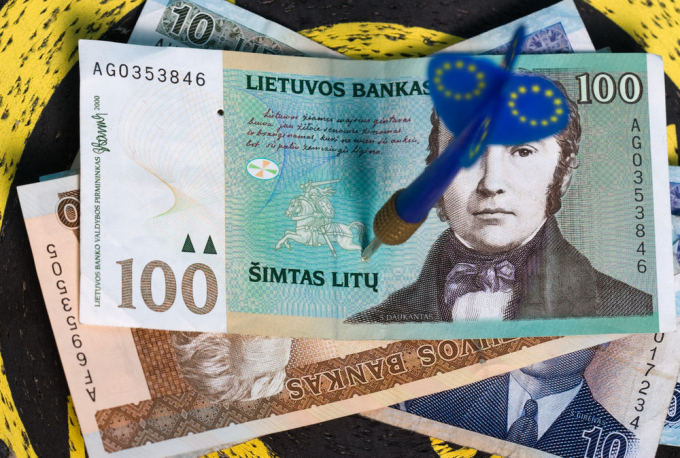 |
| Pinigai |
Sacrifice on the altar of integration
In 1994, the Bank of Lithuania introduced the currency board model and pegged the litas to the US dollar. In 2002, the litas was pegged to the euro.
After Lithuania joined the European Union, it initially aimed at introducing the euro in 2007, but the European Council decided that Lithuania did not meet all of the Maastricht criteria – the annual inflation was a mere 0.1 percentage points above the limit.
The Lithuanian government hopes to have a second and more successful shot in 2015.
With less than two years until the date, the Lithuanian public is preparing to bid farewell to the national currency. “It is a phase in history that will end – the litas is our national symbol, but when we joined the European Union, we agreed to put a fraction of our national identity on the altar of integration for the sake of common goals,” Laurinavičius says.
Seventeen EU member states, including Estonia, have already done that. Latvia will join the euro zone next year, leaving Lithuania the only Baltic state without the common currency.

